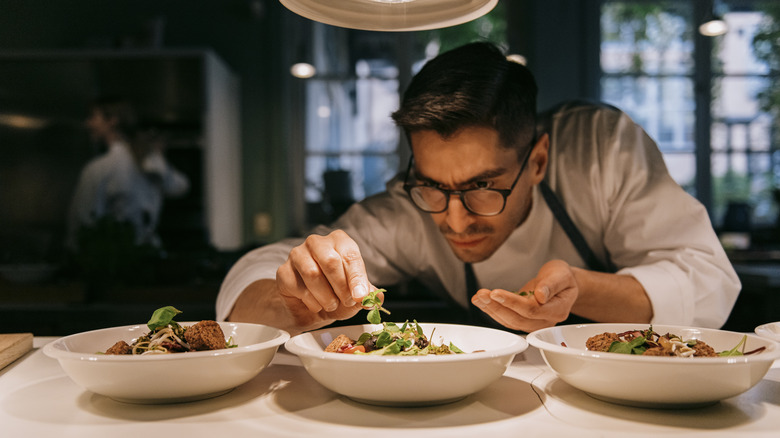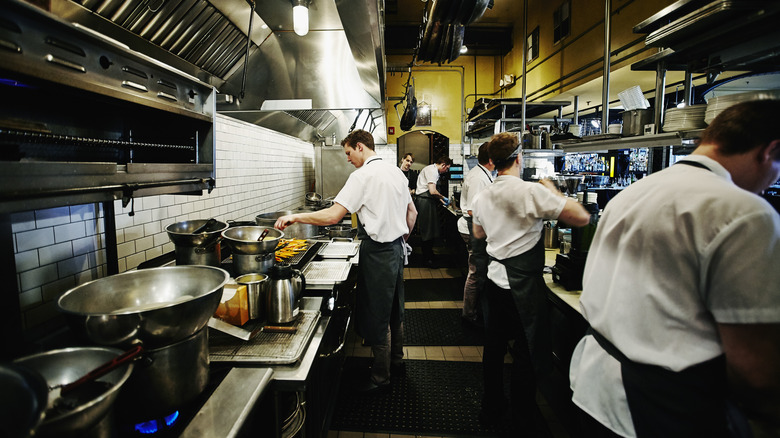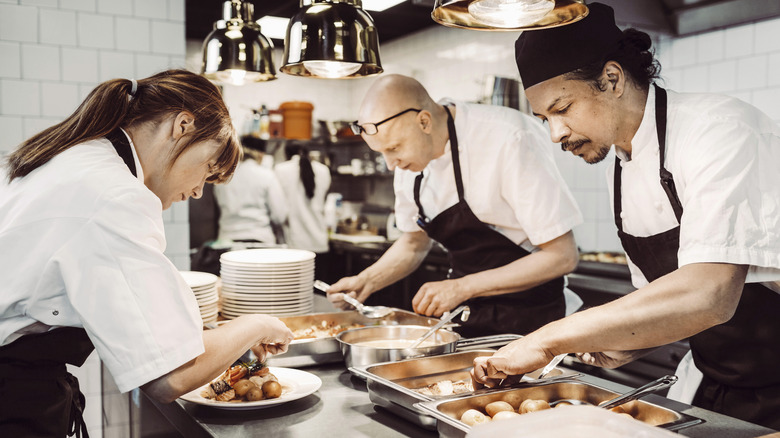Who Is The CDC In A Restaurant Kitchen And What Do They Do?
A restaurant kitchen can sometimes resemble an active war zone, completely at odds with the sedate front of house of a fine dining restaurant where diners enjoy a curated environment. Taking the metaphor a step further, the kitchen staff of any eatery worth its salt functions like a well-oiled army. As it turns out, the kitchen brigade system — a format of organizing kitchen staff that many restaurants use — was developed by an army officer. Georges-Auguste Escoffier, who served in the French army and aimed to bring the same discipline and division of roles to the kitchen, outlined a whopping 20 different cook positions. While several of the world's oldest restaurants predate this system and new ones have now largely streamlined the format, the essential positions of the brigade system endure and the CDC or Chef de Cuisine is one of them.
While a fine dining establishment will almost invariably have more layers in its kitchen staff hierarchy, you will find a CDC in almost any restaurant, including the relatively casual variety. They are the ones who ensure the kitchen is running as it should, and churning out food that is up to the mark. The CDC wears many hats and is also often the bridge between the people who are doing all the cooking and an eatery's executive branch that makes business and financial decisions. However, the CDC shouldn't be confused with the executive or sous chefs, which flank the CDC on either side in terms of kitchen hierarchy.
The Chef de Cuisine handles a kitchen's day to day activities
The CDC carries out duties that one would imagine come under the chef. The title, which literally translates to "chief of the kitchen," puts them in charge of everything from setting the menu and ensuring the kitchen is stocked and running efficiently to the presentation and taste of the dishes being served. While there may be others who handle the minutiae of some of these tasks, the buck stops at the CDC for the overall functioning of the kitchen.
What makes the CDC's role particularly challenging is that they straddle both the logistical and regulatory aspects of the kitchen (like stocking it up and ensuring food safety standards are met) as well as the day-to-day creative aspects of how the food is presented. While they are not the ones who are actually cooking or plating the food, they are responsible for every plate that leaves the kitchen.
A CDC is, therefore, the master of their kitchen but also their kitchen alone. They will generally not oversee more than one kitchen but within that kitchen, the CDC's authority is final. However, the CDC does answer to executive chefs, the restaurant's owners, and others who handle broader aspects of the restaurants.
Where do the chef, executive chef and sous chef fit in?
While the word "chef" gets thrown around quite a bit, it is a hallowed term in the culinary world. In The Bear, a popular series that delves behind the scenes of a fine dining restaurant, everyone in the kitchen is referred to as "chef" as a mark of respect. However, in many (real) kitchens, the title is earned through years of grueling experience. They not only bring skill but also a cooking philosophy to the restaurant, which is evident in the cooking tips championed by legendary chef Anthony Bourdain. Some of the most recognizable names in the culinary world — Thomas Keller, Wolfgang Puck, and Giada De Laurentiis, are all preceded by "Chef" even when they have their own restaurants.
The term chef, therefore, can be a little enigmatic, which is why in many situations it is prefixed for specificity. The executive chef is at the top of the chef hierarchy and can be in charge of multiple kitchens. They are less hands-on than the CDC, and may not be present at the restaurant at all times. The sous chef is the CDC's right hand and is most deeply entrenched in the kitchen's frontlines. They will even jump into the cooking stations when required to ensure that everything runs smoothly, and will almost always be associated with just one kitchen. With that, the next time you order at a fine dining restaurant, spend a moment mulling over the various layers of chefs your meal has gone through.


